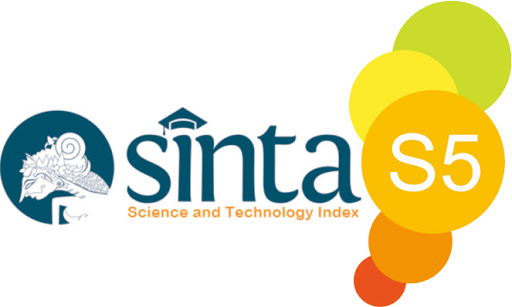Enhancing Students' Critical Thinking Skills: A STEM-Integrated Problem-Based Learning Model
Abstract
This research seeks to illustrate the enhancement of students' critical thinking abilities by adopting a problem-based learning model that employs a STEM approach. The study employed an experimental design that included a non-equivalent control group. Information was gathered using test questions about the subject of sound waves. The data on critical thinking skills were evaluated through the N-gain test, normality assessment, homogeneity assessment, paired sample t-test, independent sample t-test, and effect size analysis. The findings showed that the average N-gain of critical thinking abilities in the experimental group was 0.64, whereas in the control group it was 0.29, with both classified as moderate. The paired sample t-test produced a significance value. A (2-tailed) value of 0.000 shows a notable difference in critical thinking abilities before and after the educational process. The findings from the independent sample t-test indicated a significance. (2-tailed) value of 0.000, signifying a difference in the mean N-gain of critical thinking abilities between the experimental and control groups. The effect size analysis indicated a value of 0.82, which was classified as large. According to these findings, the problem-based learning model incorporating a STEM framework can significantly improve students’ critical thinking abilities
Keywords
Full Text:
PDFReferences
Afifah, A. (2021). Peningkatan Keterampilan Proses Sains Siswa Pada Mata Pelajaran Ipa Konsep Tekanan Zat Cair Melalui Pendekatan Stem (Science Technology Engineering Mathematic) Di Kelas Viii Smpn 4 Kota Bogor. Jurnal Pendidikan dan Pengajaran Guru Sekolah Dasar (JPPGuseda), 4(1):75-79.
Agnezi, L. A., Khair, N., & Yolanda, S. (2019). Analysis of High School Physics Textbook Presentation Class X Semester 1 Related to Science, Technology, Engineering, Mathematics (STEM) Components. Journal of Exact Education, 3(2): 167-175.
Ali, Z., & Soomro, A. A. Perceptions and practices of students about Physics Learning Materials at Secondary Level: A Comparative Study of Government and Private Schools. SBBU Journal of Social Sciences, 1(1): 23-34. Arends, R. I. (2014). Learning to Teach. New York: McGraw-Hill, 609 hlm.
Arikunto, S. (2013). Dasar-Dasar Evaluasi Pendidikan Edisi Kedua. Jakarta: Bumi Aksara, 412 hlm.
Breiner, J. M., Harkness, S. S., Johnson, C. C., & Koehler, C. M. 2012. What is STEM? A discussion about conceptions of STEM in education and partnerships. School Science and Mathematics, 112(1): 3-11.
Cahyono, B. (2017). Analisis Keterampilan Berpikir Kritis dalam Memecahkan Masalah Ditinjau perbedaan Gender. Aksioma, 8(1): 50-64
Duron, R., Limbach, B., & Waugh, W. (2006). Critical thinking framework for any discipline. International Journal of Teaching and Learning in Higher Education, 17(2): 160-166.
Eismawati, E., Koeswanti, H.D., & Radia E.H. (2019). Peningkatan Hasil Belajar Matematika Melalui Model Pembelajaran Problem Based Learning (PBL) Siswa Kelas 4 SD. Jurnal Mercumatika : Jurnal Penelitian Matematika dan Pendidikan Matematika, 3(2): 71-78.
Ennis, R. H. (2011). Critical Thinking: Reflection and Perspective Part 1. Inquiry: Critical Thinking Across the Disciplines, 26(1): 4-18.
Hake, R. R. (1998). Interactive-Engagement Versus Traditional Method: A Six Thousand-Student Survey of Mechanics Test Data for Introductory Physics Course. American Journal of Physics, 66(1): 64-74.
Hendri, M., Nehru., Rasmi, D.P., & Sirait, J.V. (2022). Pelatihan Pembelajaran IPA Melalui Pendekatan STEM (Science, Technology, Engineering, Mathematic) Bagi Guru SMP Negeri 1 Kota Sungai Penuh. Journal of Community Engagement Research for Sustainability, 2(6): 301 307.
Hendriana, H., Rohaeti, E.E., & Sumarmo, U. (2017). Hard Skills dan Soft Skills Matematik Siswa. Bandung: Refika Aditama. 284 hlm.73 .
Hidayah, R., Salimi, M., & Susiani, T., S. (2017). Critical Thinking Skill: Konsep dan Indikator Penelitian. Jurnal Taman Cendekia, 1(2): 127-133.
Hosnan, M. (2014). Pendekatan Saintifik dan Kontekstual dalam Pembelajaran Abad 21. Bogor: Ghalia Indonesia, 456 hlm.
Igut, H. J., Ain, N., & Pratiwi, H. Y. (2019). The Implementation of Problem Based Learning Model to Improve Student’s Motivation and Critical Thinking. Berkala Ilmiah Pendidikan Fisika, 7(3): 177-184.
Kelley, T. R., & Knowles, J. G. (2016). A Conceptual Framework for Integrated STEM Education. International Journal of STEM Education, 3(1): 1-11
Khoiriyah, N., Abdurrahman., & Wahyudi, I. (2018). Implementasi Pendekatan Pembelajaran STEM Untuk Meningkatkan Kemampuan Berpikir Kritis Siswa SMA Pada Materi Gelombang Bunyi. Jurnal Riset dan Kajian Pendidikan Fisika, 5(2): 53-62.
Lou, S. J., Chou, Y. C., Shih, R. C., & Chung, C. C. (2017). A Study of Creativity in CaC 2 Stemship derived STEM Project Based Learning. Eurasia Journal of Mathematics, Science and Technology Education, 13(6): 2387-2404.
Maryati, I. (2018). Penerapan Model Pembelajaran Berbasis Masalah pada Materi Pola Bilangan Di Kelas VII Sekolah Menengah Pertama. Jurnal “Mosharafa”, 7(1): 63-74.
Muthi’ik, Irmawati I., Abdurrahman, & Rosidin, Undang. (2018). The Effectiveness of Applying STEM Approach to Self Efficacy and Student Learning Outcomes for Teaching Newton’s Law. Jurnal Penelitian dan Pengembangan Pendidikan Fisika, 4(1): 11-17.
Nasution, U. S. Z., Sahyar., & Sirait, M. (2016). Pengaruh Model Problem Based Learning dan Kemampuan Berpikir Kritis terhadap Kemampuan Pemecahan Masalah. Jurnal Pendidikan Fisika, 5(2): 112-117.
Nurjanah, S., Djudin, T., & Hamdani, H. (2022). Analisis Kemampuan Berpikir Kritis Peserta Didik pada Topik Fluida Dinamis. Jurnal Education and Development, 10(3): 111-116.
Paramita, A., Dasna, I. W., & Yahmin, Y. (2019). Kajian Pustaka: integrasi STEM untuk Keterampilan Argumentasi dalam Pembelajaran Sains. J-PEK (Jurnal Pembelajaran Kimia), 4(2): 92-99.
Permana, I. P. Y. S., Nyeneng, I. D. P., & Distrik, I. W. (2021). The Effect of Science, Technology, Engineering, and Mathematics (STEM) Approaches on Critical Thinking Skills Using PBL Learning Models. Berkala Ilmiah Pendidikan Fisika, 9(1): 1-15.
Puspita, V., & Dewi, I.P. (2021). Efektifitas E-LKPD berbasis Pendekatan Investigasi terhadap Kemampuan Berpikir Kritis Siswa Sekolah Dasar. Jurnal Cendekia: Jurnal Pendidikan Matematika, 5(1): 86-96.
Ramli, Y., & Irawan, F. (2023). The Effect of STEM-Integrated PBL Learning on Students’ Critical Thinking Skills. Jurnal Jeumpa, 10(2): 269-277.
Rohman, H. N., Suherman, A., & Utami, I. S. (2021). Penerapan Problem Based Learning Berbasis STEM pada Materi Alat Optik untuk Meningkatkan Kemampuan Berpikir Kritis Peserta Didik. Jurnal Penelitian Pembelajaran Fisika, 12(2): 117-123.
Rosidin, U. (2017). Evaluasi dan Asesmen Pembelajaran. Yogyakarta: Media Akademi, 316 hlm. Sanders, M. (2009). Integrative STEM Education: Primer. The Technology Teacher, 68(4): 20-26.
Sanders, M., Hyuk-soo. K., Kyung-suk, P., & Hyonyong, L. 2011. Integrative STEM (Science, Technology, Engineering, and Mathematics) Education: Contemporary Trends and Issues. Secondary Education. 59(3): 729-762.
Septiani, I., Lesmono, A.D., & Harimukti, A. (2020). Analisis Minat Belajar Siswa Menggunakan Model Problem Based Learning Dengan Pendekatan STEM Pada Materi Vektor Di Kelas X MIPA 3SMAN2Jember. Jurnal Pembelajaran Fisika, 9(2): 64-70.
Suprihatiningrum, J. (2014). Strategi Pembelajaran Teori dan Aplikasi. Yogyakarta: Ar-Ruz Media, 375 hlm.
Simarmata, J., Simanihuruk, L., Ramadhani, R., Safitri, M., Wahyuni, D., & Iskandar, A. (2020). Pembelajaran STEM Berbasis HOTS. Medan : Yayasan Kita Menulis, 98 hlm
Refbacks
- There are currently no refbacks.

.png)










